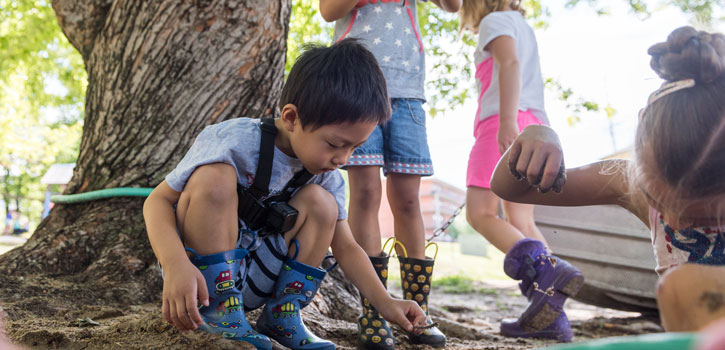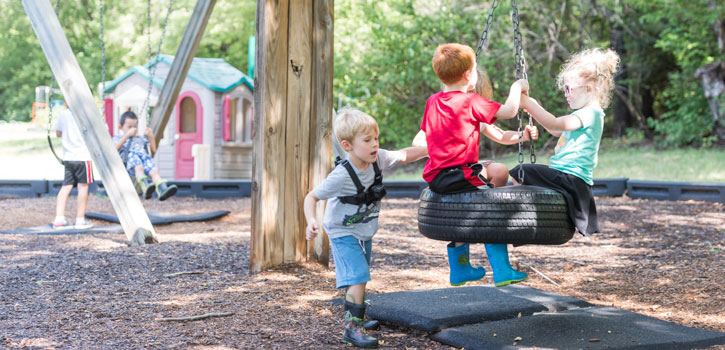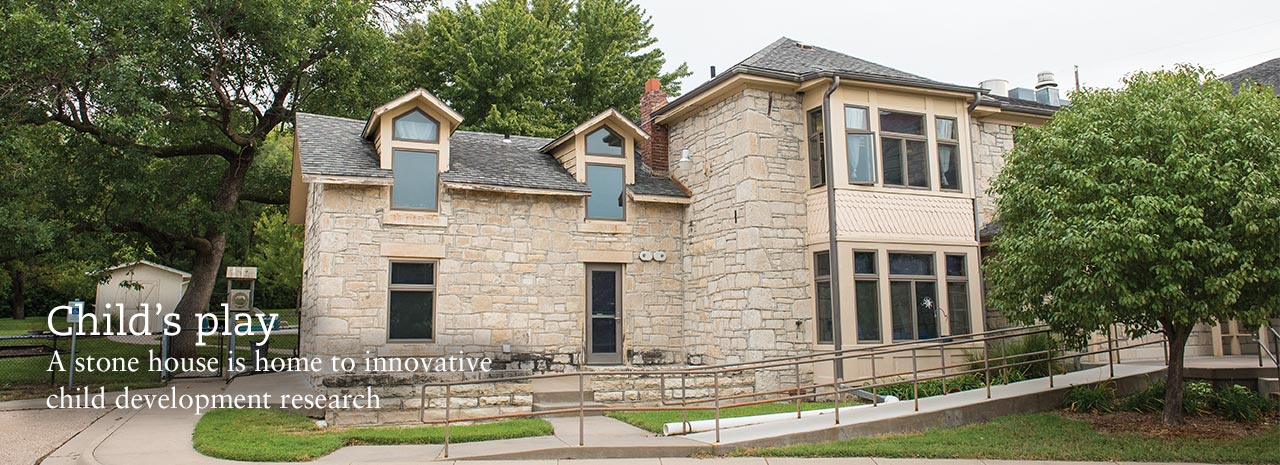Childs play: A stone house is home to innovative child development research
By Mary Lou Peter
The joyful sound of children playing fills the air as preschoolers make up games and decide who will be the leader on a warm spring morning. The scene could be any child care center or preschool across the country, but this one is different. A closer look reveals that many of the children are wearing tiny GoPro cameras that are recording their interactions with each other and with adults.
The camera recordings are part of the latest child development research project at Kansas State University’s Hoeflin Stone House Early Childhood Education Center. Researchers can observe the children without disrupting their play.
Certified early childhood teachers at Stone House teach and care for children while their parents work or attend classes. The playgrounds and classrooms are also a lab of sorts, where child development researchers observe children’s interactions with each other as well as their teachers and assistants. Stone House is a home for high-quality early education for children and families to be sure, but it is also a research site and a place where teachers and college students come to learn.
Stone House — an iconic limestone building on the Manhattan campus — was built in 1866 as a private home and was purchased by the university in 1925. It was named Hoeflin Stone House in 1977 to honor Ruth Hoeflin, dean of the College of Human Ecology from 1975 to 1983. Additions and renovations followed, and now the updated building has six classrooms as well as meeting and office space, plus three playgrounds and a classroom for K-State students majoring in early childhood education.
About 65 children attend Stone House at any given time and range in age from 6 weeks old to 5 years old.
“We strongly believe in play-based activity, but there’s a need for research of that activity to understand its role in cognitive development,” said Deborah Norris, associate professor of early childhood education and lifespan human development.
Norris and colleague Jennifer Francois, assistant professor of early childhood education, are leading research projects to delve deeper into early childhood behavior, language development and temperament in young children.
To take a closer look, Norris and Francois are leading a team that formed the Research and Inquiry Network at Stone House, also called RAIN@SH, in 2017 to facilitate research that examines connections between children’s development and learning and their early childhood experiences.
‘A fly on the wall’

Children wear GoPro cameras while they play on the playground at the university’s Hoeflin Stone House Early Childhood Education Center.
The team is particularly interested in the interplay among characteristics of adults, children and the environment they’re in on children’s development and learning, Norris said.
Two primary lines of research within RAIN@SH are “The Power of Play” and “Infants, Toddlers, Twos Language, Literacy and Learning Environments.”
For a recent six-month Stone House study, and with the consent of parents and the children themselves, preschoolers donned GoPro cameras that recorded 130 videos — hours and hours of children playing or, in some cases, staying on the sidelines. K-State students who work at Stone House then spent many more hours watching the videos to look for and code certain behaviors, such as peer interactions in pretend play. The children are not identified by name; instead, the research team is looking at how and if children’s social and cognitive play, plus their physical activity, changes over time.
The researchers also are studying how the availability and complexity of play spaces and materials influence children’s social and cognitive play as well as their physical activity.
Once recorded, quantified and analyzed, the video results will be conveyed to early childhood educators. Their insights will benefit children, teachers and parents, as well as students who are training to become teachers, Norris said. Child-directed play on playgrounds creates the foundation for language development, initiation, emotional control and complex problem-solving. Research has demonstrated long-term benefits to establishing these skills through play in a child’s early years.
“One thing that surprised us is the richness of what we have in these observations and what we can learn from them,” Francois said.
For a study on preschool leaders and followers, Makayla Norwood, senior in family studies and human services, said that as she watched the videos she observed some children always playing alone. The team is getting ready to examine differences in these leaders, followers and loners.
“There’s a need for supervision, but there is much more child-directed problem-solving when the play is happening without adult intervention,” Francois said. She added that in some cases, the children make up their own rules. “By using the GoPro cameras, you get a little bit of a sense of being a fly on the wall, which allows us to extend previous research examining children’s child-directed play.”
Another new K-State study is investigating how young children’s executive function skills — such as working memory, cognitive flexibility and self-regulation — change over time. In this study, children complete tasks on a touch-screen monitor, and their performance on these tasks over time provides an understanding of how their executive function skills change.
As part of the infant-toddler line of research, Francois has started using eye tracking to investigate how familiar caregivers influence young infants’ language skills. Data are collected beginning when the infants are 3 months old for one month. The researchers specifically want to understand how young infants come to recognize familiar caregivers. What makes a familiar caregiver familiar? How does infant attention to facial characteristics of familiar caregivers change over time? And how does infant attention to the facial characteristics of familiar caregivers differ from attention to unfamiliar people?
Opportunities for students

Preschoolers at play is the focus of recent studies at Hoeflin Stone House Early Childhood Education Center.
Norris and Francois noted that undergraduate and graduate students working at Stone House come from an array of backgrounds, including psychology, kinesiology, human development and communication sciences and disorders. Some students work directly with the children in classrooms, some help analyze data, and others conduct their own research projects under the guidance of faculty advisers.
“It’s been really nice having the diversity of students and collaborators,” Norris said. “We’re all interested in growing knowledge.”
Several graduate student-led projects are underway. Soomin Kim, doctoral student in human ecology, is researching how dramatic play influences preschoolers’ language and literacy skills, while Chelsie Yokum, master’s degree student in family studies and human services, is studying how teachers perceive preschoolers’ risky play.
Developing Scholars Program student Gabriela De La Cruz, sophomore in biology and biochemistry, is exploring gender differences in preschoolers’ playground play, and Brooke Wark, senior in communication sciences and disorders, is conducting a McNair Scholars Program project on prosocial behaviors during outdoor play.
The Developing Scholars Program and the McNair Scholars Program are designed to interest underrepresented and first-generation students in research and graduate school.
“The early childhood field is desperate for graduate students who’ve been in classrooms and have education, but who also have hands-on experience in this kind of research,” Norris said. “Research opportunities with RAIN@SH are an exciting opportunity to further students’ development while contributing to the early childhood field.”

